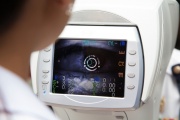Contents |
Introduction
The first surface that light entering the eye encounters is the front of the cornea, the clear, dome-shaped window which covers the iris. Because the cornea provides a major part of the focusing power of the eye, an accurate analysis of its shape and curvature is important in contact lens design or evaluating changes resulting from various disease processes.
Once, the only way to measure any part of the cornea’s shape was the keratometer, which only measured the central 3 millimeters, and in only two directions.
Now, technology has come to the rescue, with a relatively new instrument for measuring shape and curvature called a corneal topographer. In topography, a detailed surface map of the cornea is acquired and recorded by computer, which then analyses thousands of points and generates a shape-map of the surface.
Easy and Helpful
Taking a topographical reading of the cornea takes only seconds and is completely painless. Far from being limited to only 3 mm, the topographer measures the entire cornea, showing changes in curvature from flatter to steeper and any irregularities, similar to a topographical map of a mountain range, with all its hills, valleys, plateaus and cliffs.
The topographer gives the practitioner a printout of the corneal map, with different colours; blue and greenish hues usually describe flatter areas, while steeper curvatures are represented by orange and red.
Absolutely Necessary
A topographical map of the cornea is invaluable in evaluating changes to the corneal curvature that are a hallmark of some conditions like keratoconus, where the cornea begins to become thinner in some areas and tends to bulge outward. Keratoconus is usually treated with rigid contact lenses which help stabilize the corneal curvature and push it back into a more spherical shape; topographical maps are extremely helpful in designing the lenses and evaluating their effectiveness over time.
Refractive surgery is another area where topography is important in planning the type of surgery. In LASIK, corneal tissue is removed by the laser, giving it a flatter profile; topography helps determine how much.
In cataract extraction surgery or clear lens extraction, topography helps determine the power of the implanted lens that replaces the natural lens behind the iris where the cataract is located. In most cases of cataract surgery, the implanted lens allows the patient to see much more clearly than before, even without corrective eyewear. Most people are much less dependent on their eyeglasses than previously.
The Changing Shape of Eyecare
Technology over the past few years has taken giant leaps forward, and provides eyecare practitioners and other health care professionals with options for treatment that were never available before. Better technology from better measurements from better instrumentation equates to better outcomes in just about every area of health care.
Corneal topography is just one aspect of this forward trend, and it is a significant one without doubt. If or when you have it done, take a few minutes to look over your topographical corneal maps, because it is quite interesting.

